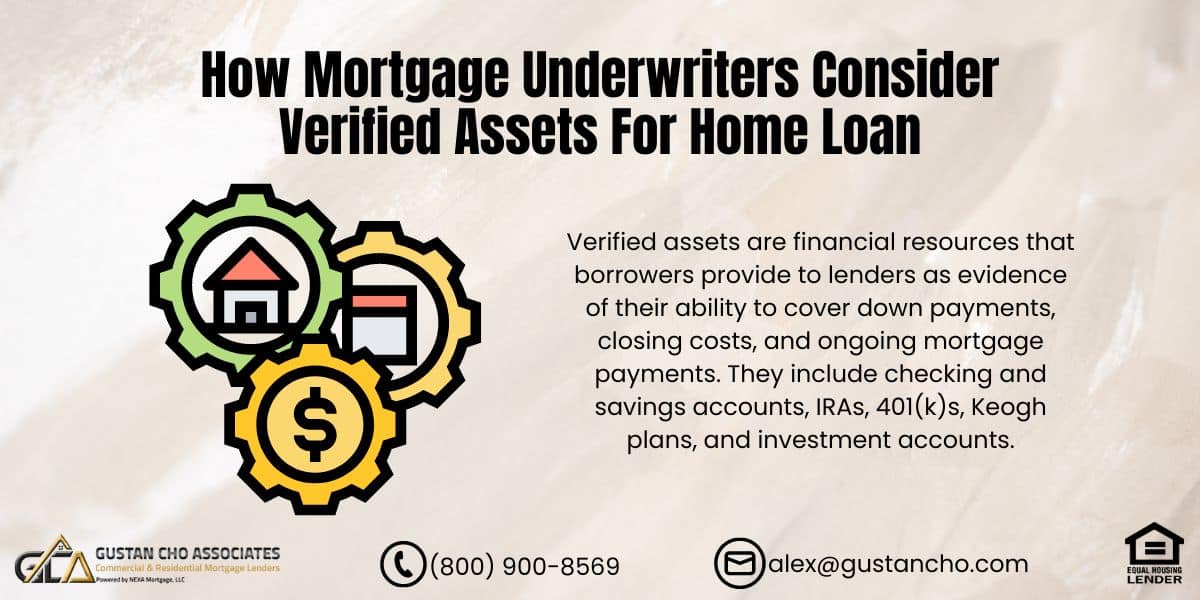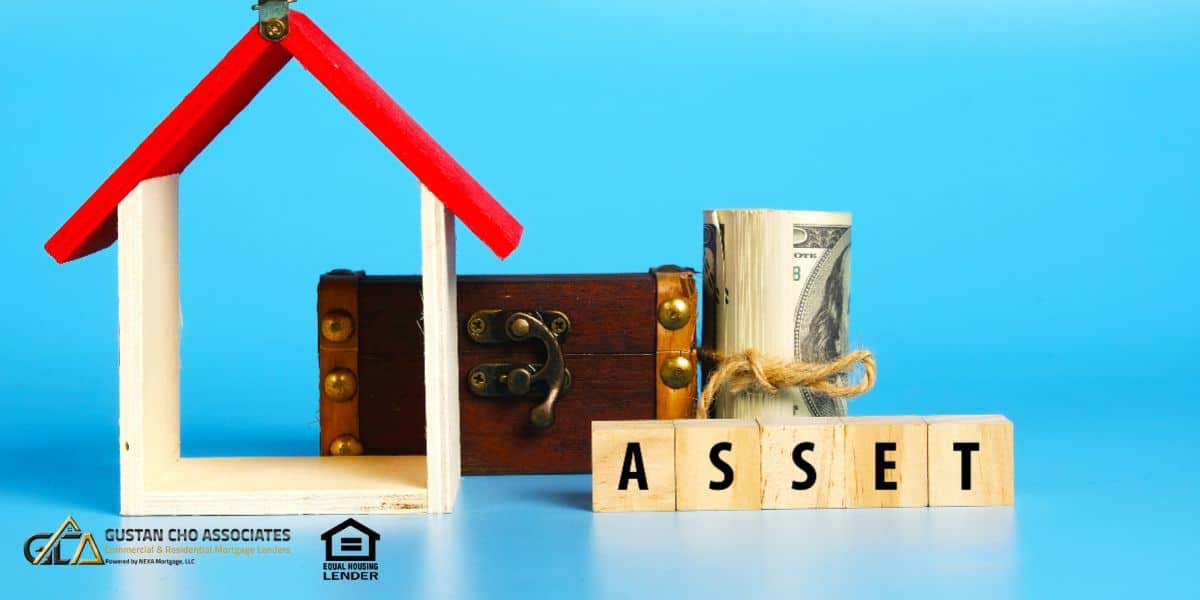When applying for a mortgage loan, homebuyers must present verified assets for home loan to the lender. Verified assets include the following:
- Checking accounts
- Savings accounts
- IRAs
- 401(k) accounts
- Keogh plans
- Investment accounts
All assets must be properly sourced and verified to count towards a home loan. Cash is not recognized as verified funds in the mortgage world.
Before granting a “clear to close,” lenders require borrowers to have verified assets to cover the down payment and closing costs of the home purchase. Every loan program follows strict guidelines concerning verified assets.
This article will explore how mortgage underwriters consider assets during the application process.
How do Underwriters Verify Assets?
Underwriters confirm verified assets for home loans through various methods to ensure borrowers possess sufficient financial stability. Key steps include:
- Document Collection: Borrowers submit bank statements, investment account summaries, and retirement account statements. Underwriters carefully review these to verify accuracy and consistency.
- Direct Verification: Some underwriters reach out directly to financial institutions to verify balances or investment holdings, ensuring the legitimacy of submitted documents.
- Appraisals and Evaluations: If real estate is involved, an appraisal may be conducted to determine the property’s market value, as with mortgage loans. Specialized evaluations are also performed for other significant assets like vehicles.
- Income and Employment Verification: Salaries, business earnings, and other income-related assets are verified using tax returns, pay stubs, and employer confirmations.
- Credit Report Analysis: Credit reports are analyzed to evaluate debt obligations and confirm that the declared assets align with the borrower’s financial profile.
- Third-Party Verification Services: Some underwriters employ third-party verification services to establish the value and legitimacy of certain assets.
- Affidavit Requirements: Borrowers may need to sign affidavits attesting to the ownership and valuation of particular assets.
These measures help underwriters comprehensively understand the borrower’s financial health and assess the risk involved in lending.
Want to Get Approved for a Home Loan? Let’s Make Sure Your Assets Are Verified!
Contact us today to ensure your assets are properly verified and move smoothly through the underwriting process.
Copies of Cashier’s Checks Or Canceled Checks On Earnest Money
Avoid paying earnest money in cash, as it isn’t considered a verified asset for home loans in the mortgage industry. Instead, use a bank or cashier’s check and keep a copy for your records. This documentation will confirm verified assets for a home loan, which your mortgage lender will need.
Furthermore, 60 days’ worth of bank statements will be required so the lender can verify the deduction of earnest money from your bank account.
Once verified as part of your verified assets for a home loan, the earnest money will be applied toward your home purchase’s down payment.
What Assets Do Underwriters Look For?
Underwriters carefully examine various verified assets for home loan to assess the borrower’s financial stability and repayment potential. Key assets considered include:
- Liquid Assets:
- Bank Accounts: Checking and savings accounts are important because they show readily available funds.
- Cash Reserves: This includes any emergency funds or easily accessible cash that could cover a few months’ expenses.
- Investment Accounts:
- Brokerage Accounts: Stocks, bonds, mutual funds, and other investments provide insight into the borrower’s long-term financial health.
- Retirement Accounts: While not always immediately accessible, 401(k) plans, IRAs, and similar accounts are considered.
- Certificates of Deposit (CDs): These can be used as collateral or provide backup liquidity.
- Real Estate:
- Primary Residence: If owned, it adds to the borrower’s net worth and financial stability.
- Investment Properties: Rental and vacation homes can provide additional income and equity.
- Vacant Land: This may be counted as an asset depending on market value and zoning.
- Vehicles:
- Cars, Boats, etc.: Underwriters may include vehicles of significant value if they are fully paid off and not under lease or loan.
- Business Assets:
- Ownership Stakes: If a borrower owns a business or part of one, underwriters may include its value based on the type of business and financial performance.
- Equipment: In cases where the business owns valuable equipment.
- Personal Property:
- Valuable Items: Art, jewelry, and other valuable items may sometimes be counted but usually require third-party appraisals.
Underwriters use these assets to assess the borrower’s financial position, repayment ability, and overall creditworthiness.
Checking And Savings Accounts Are Verified Assets For Home Loan
Lenders typically require two months of bank statements to verify assets for home loan. Any significant or unusual deposits will be scrutinized, and their sources must be verified. All pages of the bank statements or bank printouts should be provided, even if some are blank.
This requirement exists because bank statements are sequentially labeled (e.g., page 1 of 7, page 2 of 7). Even if a page is missing or blank, lenders must account for it to confirm completeness.
Irregular And Large Deposits
All significant and irregular deposits must be documented to be counted as verified assets for home loan. For instance, a mortgage underwriter will recognize regular paycheck deposits directly made into a wage earner’s checking account as sourced deposits, showing that the funds originated from an employer.
However, underwriters will investigate its source if an irregular $5,000 deposit is made into a bank account. With proper documentation, a cash gift from a relative can be considered a verified asset for a home loan, provided there is sufficient paperwork for the $5,000 deposit.
Ready to Buy a Home? We’ll Help You Verify Your Assets for a Smooth Approval Process!
Contact us today to discuss how we can help you provide the right documentation.
Need Papertrail And Documentation For Large And Irregular Deposits
To use the $5,000 deposit as verified assets for home loan, borrowers must provide documentation that establishes a clear paper trail. Acceptable documents include:
- Sale of a Car: Key documents required include a copy of the check, the bill of sale, the vehicle title, and the deposit slip.
When borrowers supply these documents, the $5,000 is recognized as verified assets for a home loan. These sourced funds can be applied toward the down payment or closing costs when purchasing a home.
Retirement Accounts Are Verified Assets For Home Loan
IRAs, 401(k)s, and Keogh accounts are verified assets that can be utilized while applying for a home loan. It is possible to use these accounts as proof of financial stability and credibility during the loan application process. These accounts can help to establish a positive credit history and prove the borrower’s ability to make timely payments.
Typically, 60% of the value of these accounts can be used as verified assets for a home loan. In comparison, the remaining 40% can be utilized as reserves if required by the underwriter.
Reserves must consist of the borrower’s funds and cannot be gifted. For properties with 3-4 units, underwriters generally require three months of reserves to cover principal, interest, taxes, and insurance (PITI).
Borrowers must provide copies of their retirement plans, especially the withdrawal agreements. If borrowers choose to take loans from their IRAs, 401(k)s, or Keogh accounts, the repayments will not count toward their debt-to-income ratios, as it is seen as borrowing against oneself.
Gift Funds Can Be Used As Verified Assets for Home Loan
Gift funds from a relative can be used as verified assets for home loan for the down payment and closing costs purposes only. Gift Funds cannot be used for reserves or to pay off existing consumer debts.
Real Estate Agent As Home Buyers
If you are a real estate agent and are purchasing a home, you can use your real estate commissions towards your down payment as verified assets for home loan.
If you have any questions about how mortgage underwriters consider verified assets for home loans or you need to qualify for home loans with a lender with no overlays, please contact us at 800-900-8569. Text us for a faster response. Or email us at alex@gustancho.com. The team at Gustan Cho Associates is available 7 days a week, on evenings, weekends, and holidays.
Frequently Asked Questions: How Mortgage Underwriters Consider Verified Assets For Home Loan
- What are verified assets for a home loan? Verified assets are financial resources that borrowers provide to lenders as evidence of their ability to cover down payments, closing costs, and ongoing mortgage payments. They include checking and savings accounts, IRAs, 401(k)s, Keogh plans, and investment accounts.
- Why are verified assets important for a home loan application? Verified assets are crucial because they assure lenders that borrowers have the funds to fulfill their mortgage obligations. This assessment includes the ability to cover the initial down payment, closing costs, and reserves required for the loan.
- How do underwriters verify assets? Underwriters utilize various techniques to verify the legitimacy and accuracy of the assets provided. They review bank and investment account statements and directly contact financial institutions for verification. Additionally, they order appraisals to determine the value of real estate or other valuable assets and verify employment and income through pay stubs, tax returns, and employer confirmation.
- What documents are required for verification? Borrowers generally must provide recent bank statements, investment account summaries, retirement account documentation, and affidavits confirming ownership and valuation. In addition, all pages of bank statements must be submitted to account for potential irregular deposits.
- Can cash be used as verified assets? No, cash is not recognized as verified funds in the mortgage industry. Borrowers should use bank or cashier’s checks for earnest money and retain copies of these checks as proof.
- How much can my retirement account value be considered a verified asset? Typically, 60% of the value of an IRA, 401(k), or Keogh account can be used as a verified asset for a home loan. The remaining 40% may be counted as reserves if required.
- What are reserves, and how much is required? Reserves are additional funds that demonstrate a borrower’s financial stability. They cannot be gifted and should be the borrower’s own funds. For properties with 3-4 units, underwriters generally require three months of reserves covering principal, interest, taxes, and insurance (PITI).
- Can gift funds be used as verified assets? Yes, gift funds from a relative can be used for down payment and closing costs but not as reserves or to pay off existing consumer debts.
- Can real estate agents use their commissions as verified assets? Yes, real estate agents can apply their earned commissions toward their down payment as verified assets for a home loan.
- What happens if my account has irregular or large deposits? Underwriters will scrutinize all irregular or large deposits. You may need to provide a paper trail, such as bills of sale, titles, and deposit slips, to verify the deposit’s source.
- How do loans from retirement accounts affect my debt-to-income ratio? Suppose you borrow against your IRA, 401(k), or Keogh account. In that case, the repayment amounts do not impact your debt-to-income ratio because these loans are considered borrowing from oneself.
Related> Unsourced fund in mortgage approval process
Related> Funds in bank statements
This blog about how mortgage underwriters consider verified assets for home loans was updated on May 8th, 2024.
Need Help Verifying Assets for Your Mortgage? We’ll Help You Meet Underwriter Requirements!
Reach out now to ensure you have everything in order for a smooth approval.










